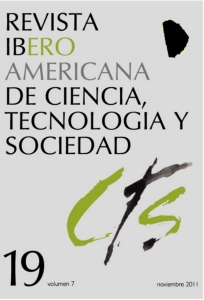El artefacto, ¿estructura intencional o sistema autónomo?
La ontología de la función artefactual a la luz del intencionalismo, el dualismo y la filosofía de Gilbert Simondon
DOI:
https://doi.org/10.52712/issn.1850-0013-740Palabras clave:
función, estructura, dualismo, SimondonResumen
El presente trabajo aborda un análisis comparativo entre la noción de función, tal como ha sido desarrollada en la filosofía analítica, y la noción de función en la filosofía de Simondon. Se examina la relación entre agencia, intencionalidad, y el uso y producción de artefactos en ambos enfoques. Una característica llamativa es que en la filosofía de Simondon no se establece la distinción entre función y estructura, la cual es central en el dualismo artefactual. Finalmente se examina la noción sistémica de la función desarrollada por Cummins en el lado analítico, la cual se considera complementaria o afín a la de Simondon.
Descargas
Citas
ARTHUR, B. W. (1989): “Competing technologies, increasing returns, and lock-in by historical events”, Economic Journal, 99, pp. 116-31.
ARTHUR, B. W. (2009): The nature of technology: What it is and how it evolves, Washington, The Free Press.
BAKER, L. (2004): “The ontology of artefacts”, Philosophical Explorations, vol. 7, nº 2, pp. 99-111.
BULLER, D. (1998): “Etiological theories of function: A geographical survey”, Biology and Philosophy, 13, pp. 505-527.
CARRARA, M. y VERMAAS, P. (2009): “The fine-grained metaphysics of artefactual and biological functional kinds”, Synthese, 169, pp. 125-143.
CUMMINS, R. (1975): “Functional analysis”, Journal of Philosophy, 72, pp. 741-765.
DAVID, P. (1985): “Clio and the economics of QWERTY”, American Economic Review, 75, pp. 332-37.
DIPERT, R. (1995): “Some issues in the theory of artefacts: Defining ‘artefact’ and related notions”, Monist, 78(2), pp. 119-136.
ELDER, C. (2007): “On the place of artefacts in ontology”, en E. Margolis y S. Laurence (Eds.): Creations of the mind: essays on artefacts and their representation, Oxford, Oxford University Press, pp. 33-51.
HILPINEN, R. (1993): “Authors and artefacts”, Proceedings of the Aristotelian Society, New Series, 93, pp. 155-178.
HOUKES, W., VERMAAS, P., DORSO, K. y DE VRIES, M. J. (2002): “Design and use as plans: an action-theoretical account”, Design Studies, 23, pp. 303-320.
HOUKES, W. y MEIJERS, A. (2006): “The ontology of artefacts: the hard problem”, Studies in History and Philosophy of Science, 37, pp. 118-131.
HOUKES, W. y VERMAAS, P. (2009): “Contemporary engineering and the metaphysics of artefacts: Beyond the artisan model”, The Monist, 92(3), pp. 403-419.
ILLIES, C. y MEIJERS, A. (2009): “Artefacts without agency”, The Monist, 92(3), pp. 420-440.
KROES, P. y MEIJERS, A. (2006): “Introduction: The Dual Nature of Technical Artefacts”, Studies in History and Philosophy of Science, 37, pp. 1-4.
LEWENS, T. (2004): Organisms and artefacts: Design in nature and elsewhere, Cambridge, MIT Press.
MITCHAM, C. (2002): “Do artefacts have dual natures? Two points of commentary on the Delft Project”, Techné, vol. 6, nº 2.
MONTOYA SANTAMARÍA, J. W. (2006): La individuación y la técnica en la obra de Gilbert Simondon, Medellín, Editorial Universidad EAFIT.
MUMFORD, S. (2006): “Function, Structure, Capacity”, Studies in History and Philosophy of Science, 37, pp. 76-80.
PRESTON, B. (1998): “Why is a Wing like a spoon? A pluralist theory of function”, The Journal of Philosophy, vol. 95, nº 5, pp. 215-254.
SEARLE, J. (1995): The construction of social reality, Nueva York, The Free Press.
SIMONDON, G. (2008): El modo de existencia de los objetos técnicos, Buenos Aires, Prometeo.
SIMONDON, G. (2009): La individuación a la luz de las nociones de forma y de información, Buenos Aires, Editorial Cactus & La Cebra.
TENNER, E. (1996): Why things bite back: Technology and the revenge of unintended consequences, Nueva York, Alfred A. Knopf.
THOMASSON, A. (2003): “Realism and human kinds”, Philosophy and Phenomenological Research, vol. 67, nº 3, pp. 580-609.
THOMASSON, A. (2007): “Artefacts and human concepts”, en E. Margolis y S. Laurence (Eds.): Creations of the mind: essays on artefacts and their representation, Oxford, Oxford University Press, pp. 52-73.
TOSCANO, A. (2007): “Technical culture and the limits of interaction: A note on Simondon”, en J. Brouwer y A. Mulder (Eds.): Interact or Die!, Rotterdam, NAi, pp. 198-205
VERMAAS, P. (2009): “On unification: Taking technical functions as objective (and biological functions as subjective)”, en U. Krohs y P. Kroes (Eds.): Functions in biological and artificial worlds: Comparative philosophical perspectives, Cambridge y Londres, MIT Press, pp. 69-87.
VERMAAS, P. y HOUKES, W. (2006): “Technical functions: A drawbridge between the intentional and structural natures of technical artefacts”, Studies in History and Philosophy of Science, 37, pp. 5-18.
WOUTERS, A. (2005): “The function debate in philosophy”, Acta Biotheoretica, 53, pp. 123-151.
Descargas
Publicado
Cómo citar
Número
Sección
Licencia
Derechos de autor 2024 CC Attribution 4.0

Esta obra está bajo una licencia internacional Creative Commons Atribución 4.0.
Todos los números de CTS y sus artículos individuales están bajo una licencia CC-BY.
Desde 2007, CTS proporciona un acceso libre, abierto y gratuito a todos sus contenidos, incluidos el archivo completo de su edición cuatrimestral y los diferentes productos presentados en su plataforma electrónica. Esta decisión se sustenta en la creencia de que ofrecer un acceso libre a los materiales publicados ayuda a un mayor y mejor intercambio del conocimiento.
A su vez, para el caso de su edición cuatrimestral, la revista permite a los repositorios institucionales y temáticos, así como también a las web personales, el auto-archivo de los artículos en su versión post-print o versión editorial, inmediatamente después de la publicación de la versión definitiva de cada número y bajo la condición de que se incorpore al auto-archivo un enlace a la fuente original.











